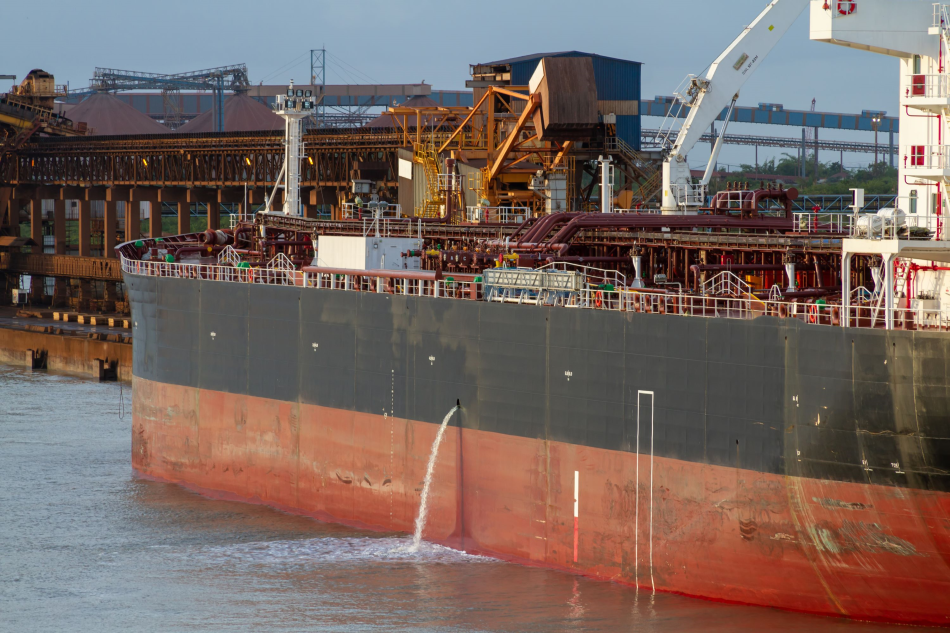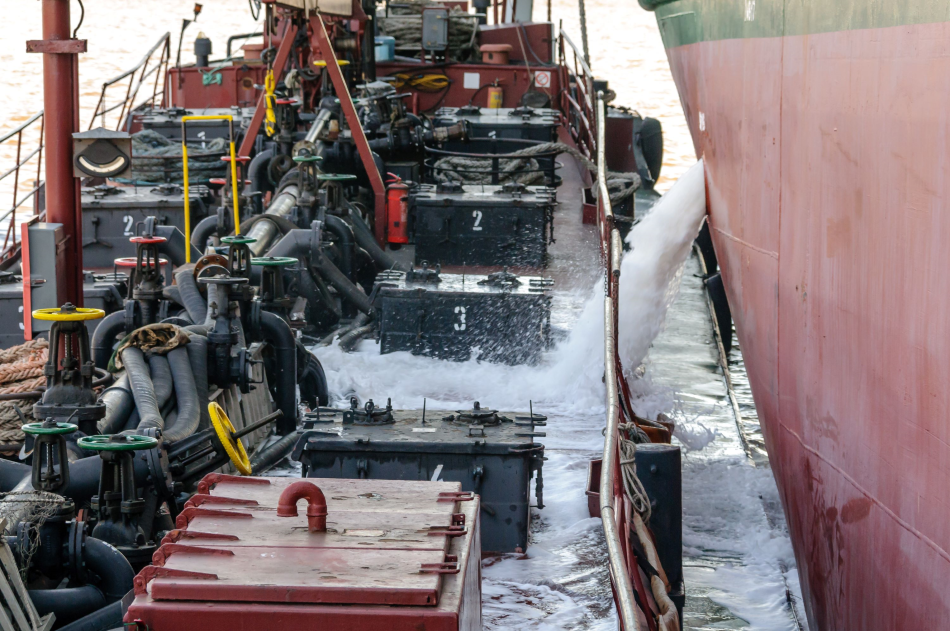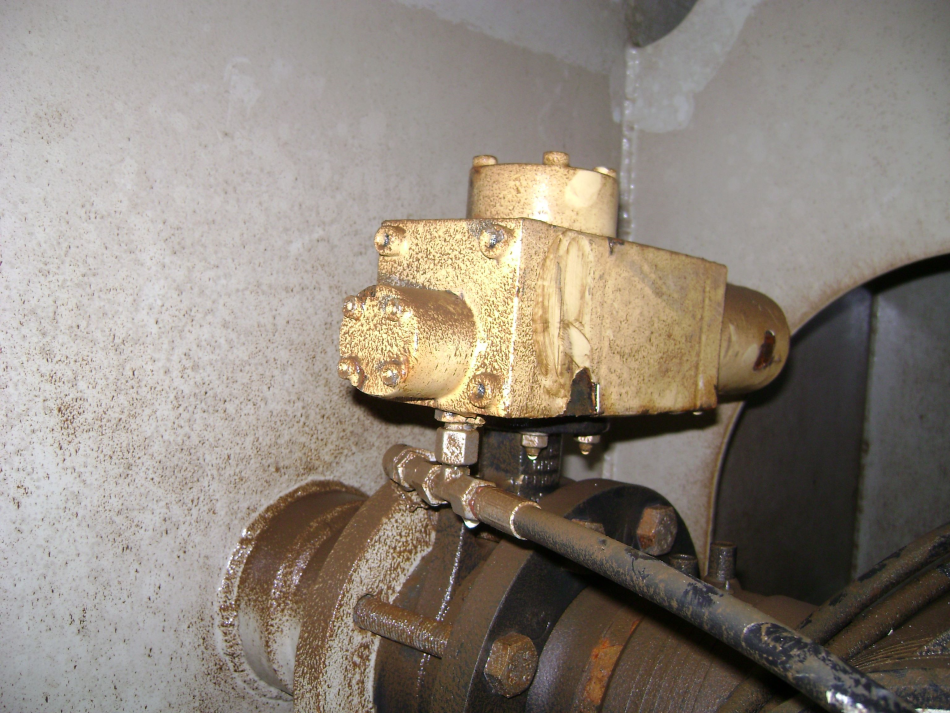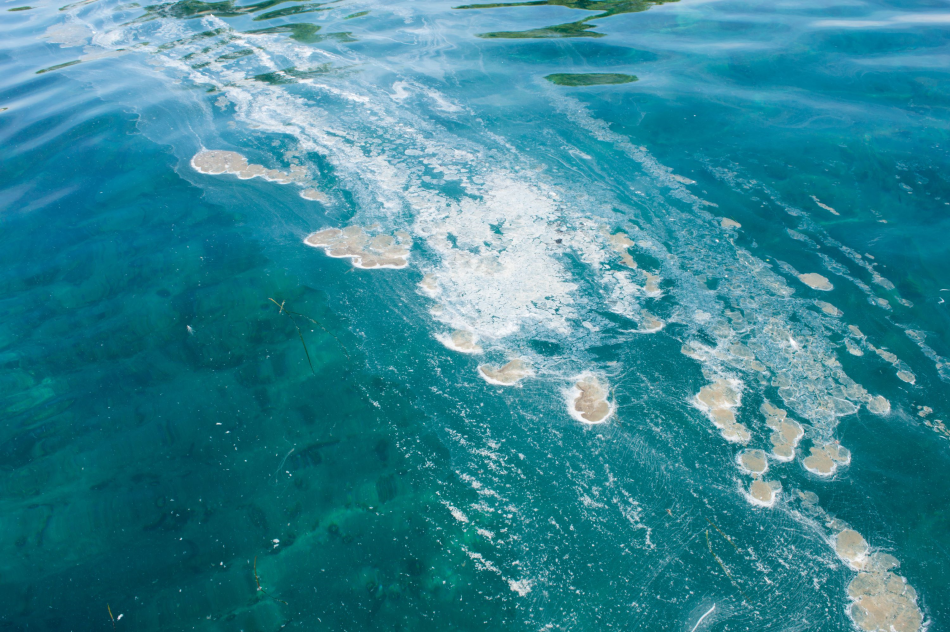This website uses cookies so that we can provide you with the best user experience possible. Cookie information is stored in your browser and performs functions such as recognising you when you return to our website and helping our team to understand which sections of the website you find most interesting and useful.
BALLAST OPERATION AND MAINTENANCE PRACTICE
Published: 27 July 2023
The Club has seen several pollution incidents involving the accidental transfer of cargo into an adjacent ballast water tank. The main causes are pitting or corrosion of cargo tanks which results in cargo being flushed out during ballast water operations. These incidents have highlighted the importance of crew awareness of ballast principles and best practices. In this guidance we will explore best ballast practice and how to maintain ballast tanks to prevent such claims.

Figure 1 – Ship de-ballasting
BALLAST PREPARATION
The main purposes of ballasting are to maintain the stability of a vessel, adjust the list and/or trim while at port to facilitate the cargo operation, to optimise a vessel’s performance and reduce fuel costs. The International Ballast Water Convention[1] (BWT) requires onboard ballast water management to help reduce potential ecological impact on the marine environment. However, a well implemented ballast practice remains crucial to avoid incurring expensive pollution fines due to potential contamination of the on board ballast water.
Therefore, it is important that the regulations of the BWT, the approved Ballast Water Management Plan and any local regulations are followed. The company’s Safety Management System (SMS) should also include procedures on ballasting operations to ensure it is carefully planned and executed. Planning considerations for the ballast process should include:
- Training and familiarising the crew with the onboard ballast system, the line setup, ballast water treatment system and associated equipment.
- Ensuring efficient ballast tank management, including regular inspection of tank-fitted alarms and sounding equipment. This will help prevent the accumulation of sediment or debris that could be of an invasive species.
- Assessing the suitability and quality of the water to be taken on as ballast. If possible, the ballasting required may be achieved by internal transfer of the ballast water already carried on board.
- Determining the amount of ballast water required for stability and trim during the different phases of the cargo operation and voyage. This includes ensuring that vent closures are open for the tanks being ballasted.
- Producing a ballast water plan, which stipulates the required ballast amount and sequence of tanks to be filled and emptied. Also taking into consideration any pump limitations and planning ballasting at a safe rate.
- Considering free surface effects as a result of tanks that are not pressed.
- Obtaining a loading/discharge sequence prior to the cargo operation. If the provided sequence plan raises any stability or hull stress concerns which cannot be compensated by the use of ballast, this should be brought to the attention of the terminal immediately for rectification.
- Ensuring all ballast tank level measuring gauges are working and provide reliable soundings. For manual sounding, suitable sounding intervals and reporting should be agreed. If operating in Arctic areas, ensuring the sounding pipes and tank level gauges are not affected by the extreme cold weather.
- Maintaining and updating ballast water management records as required.
- Considering nearby vessels. This is important for bunkering purposes so the de-ballasting does not cause damage or impact its safety.
- Considering the locations of shore installations to ensure de-ballasting operations do not cause damage, particularly to electrical items.
- Taking care when ballasting in shallow waters as it can cause ballast pump strainers to choke and sediment deposits to gather inside tanks.

Figure 2 – Beware what is alongside before de-ballasting
MONITORING
The ballast operation should be monitored throughout by a duly qualified deck officer, with the deck crew using a reliable means of communications. It should be verified that the ballast water is flowing as intended and the designated tanks are filled/emptied at the expected rate. If there is any doubt, the ballast operation should be stopped until the root cause is identified and rectified. To avoid potential fines, ballast tanks should not be allowed to overflow through airpipes. If manual soundings are conducted, these should be carried out at agreed intervals and be reported to the officer in charge of the ballast operation.
During de-ballasting, frequent ‘over the side’ visual observations of the discharged ballast water should be carried out to determine if there are any signs of contamination. If it does, the ballast operation should be stopped immediately and the root cause investigated.
Furthermore, the officer in charge of the ballast operation should be familiar with all fitted alarms and react promptly if they are activated. They should also be aware of any alarm not being activated as expected. Some vessels may be installed with a gas sampling system in its ballast tanks. This system is to provide an alarm should any cargo accidentally run into an adjacent ballast tank e.g., due to corrosion, and cause a potential dangerous atmosphere to develop within the ballast tank. While this system may provide a warning about ballast water contamination then it cannot solely be relied on for this purpose. Depending on the model it may be required to be disconnected when a ballast tank is full. Also, sufficient headspace within the ballast tank will be required for a dangerous atmosphere to develop and for the system to provide a warning of this.
Therefore, familiarisation with the ballast system and monitoring the operation by applying good ballast management practice remains vital. Similarly, ensuring accurate ballast tank management, including regular inspection and maintenance, is also important.

Figure 3 – The ballast operation should be properly monitored at all times
BALLAST TANK MAINTENANCE
Maintenance and inspections of ballast tanks is key to ensure the structural integrity of tanks. As part of a vessel’s Planned Maintenance System (PMS), a robust maintenance schedule for the ballast tanks, including cleaning, inspection and repairs should be implemented. Regular inspections help identify any potential issues or structural damage to the ballast tanks. This allows for timely repairs and therefore helps mitigate the risk of incidents. To ensure maintenance of the onboard ballast tank system the following precautions should be taken:
Conducting regular inspections of the ballast tanks and associated pipework to identify any signs of damage, such as cracks, deteriorated welding seams, corrosion, or structural weaknesses. These inspections should include thorough visual examinations, non-destructive testing techniques, such as ultrasonic testing or magnetic particle inspection, and thickness measurements of the tank walls. Ideally, photographs should be taken and kept as a record of visual inspections.

Figure 4 – Conduct thorough tank inspections to ensure the tank and its equipment is in a good condition
- Checking manhole covers to ensure that sealing arrangements are free of debris, the gasket is in satisfactory condition and all nuts and bolts are in place and correctly cross-tightened.
- Periodic hydrostatic testing of ballast tanks surrounding the cargo holds should also be considered as part of a vessel’s planned maintenance system and conducted at suitable intervals when the holds are cargo free.
- Ensuring the surface is properly prepared before applying any protective coatings or treatments to the ballast tanks. This includes cleaning, removing rust and scale.
- Applying appropriate protective coatings to prevent corrosion. These coatings should have corrosion resistant and be able to withstand the harsh marine environment.
- Monitoring and maintaining cathodic protection systems to ensure their effectiveness. This may include periodically measuring the current and potential differences to assess the performance of the system and maintaining and replacing corroded anodes as per the manufacturers’ instructions.
- Regularly monitoring the quality of the water inside the ballast tanks to identify any potential sources of contamination. This includes testing for pollutants, chemicals and biological organisms that could lead to cross-contamination or damage to the ballast tanks. Also being aware of any unusual odour from the ballast tank venting system or sounding pipe.

Figure 5 – Pollutants
- Promptly addressing any structural damage to the ballast tanks. This includes repairing any cracks, dents, or structural weaknesses that may affect the integrity of the tanks and notifying the vessels’ classification society to determine further repair requirements.
- Where there is a sign or suspicion of a ballast tanks integrity being compromised, ensuring it is not used before an investigation and any required repairs have been conducted. This also applies to adjacent tanks or compartments that may be affected by potential structural damage.
It should also be noted that any inspection or work inside a ballast tank should be governed by Members’ entry into enclosed space procedures and Permit to Work system, implementing the provisions stipulated by IMO’s Resolution A.1050(27) ‘Revised recommendations for entering enclosed spaces aboard ships’.
CONCLUSION
Applying best ballast water management practice is essential in order to comply with applicable regulations and to prevent a costly claim. The maintenance and inspection of marine ballast tanks plays a crucial role in preventing leakage and cross-contamination. It is important to implement suitable measures, such as regular maintenance, appropriate drainage and cleaning, and efficient monitoring of water quality. Robust inspections will also help to identify any structural damage promptly. Providing training and education to the crew involved in operating and maintaining the ballast water system will help in mitigating the risk of pollution claims during ballast operations.
For further information, please do not hesitate to email lossprevention@tindallriley.com.
DISCLAIMER
This Loss Prevention Guidance article is published by THE BRITANNIA GROUP. Whilst the information is believed to be correct at the date of publication, the Association cannot, and does not, assume any responsibility for the completeness or accuracy of that information. The content of this publication does not constitute legal advice and Members should always contact the Association for specific advice on a particular matter.
[1] International Convention for the Control and Management of Ships’ Ballast Water and Sediments adopted by the International Maritime Organization in 2004

 English
English